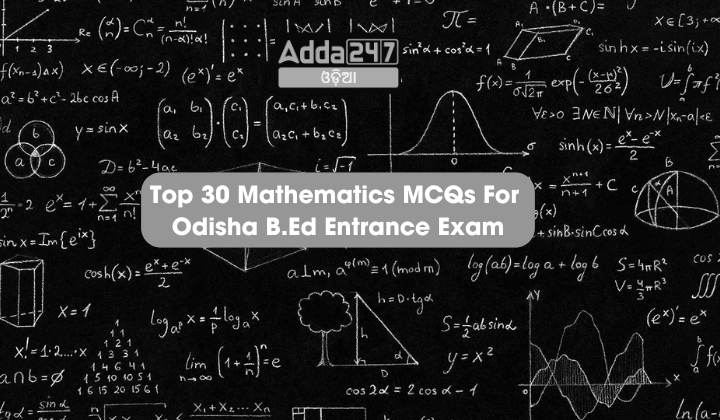The Odisha B.Ed Entrance Exam is a crucial step for aspiring teachers, requiring a strong grasp of various subjects, including mathematics. Here are 30 multiple-choice questions (MCQs) to help you prepare effectively for the mathematics section of the exam.
Top 30 Mathematics MCQs For Odisha B.Ed Entrance Exam
- Which of the following number systems is based on a radix of 10?
A) Decimal number system
B) Binary number system
C) Octal number system
D) Hexadecimal number system
ANS:- A) Decimal number system
Sol:- In the decimal number system, the radix or base is 10. It uses digits from 0 to 9 to represent numbers. Therefore the correct answer is A) Decimal number system - What is the base of the binary number system?
A) 8
B) 2
C) 16
D) 10
ANS:- B) 2
Sol:- The binary number system is based on a radix or base of 2. It uses digits 0 and 1 to represent numbers. - Which of the following is the correct representation of the number five in binary?
A) 101
B) 100
C) 110
D) 111
ANS:- B) 101
Sol:- In binary, the number 5 is represented as 101, which corresponds to
= 1 x 22 + 0 x 21 + 1 x 20
= [1 x (2 x 2)] + [0 x (2 x 1)] + [1 x 20]
= (1 x 4) + (0 x 2) + (1)
= 4 + 0 + 1
= 5 - Which of the following is the correct representation of the number fifteen in hexadecimal?
A) F
B) 10
C) 15
D) 1F
ANS:- D) 1F.
Sol:- The correct representation of the number fifteen in hexadecimal is D) 1F.
In hexadecimal, the numbers 0 to 9 are represented as usual, and the numbers 10 to 15 are represented as A to F respectively. So, 15 in hexadecimal is represented as 1F. - Which of the following is a prime number?
A) 20
B) 17
C) 16
D) 15
ANS:- B) 17
Sol:- A prime number is a positive integer greater than 1 that has no positive divisors other than 1 and itself.
Let’s check each option:
A) 20 – This is not a prime number because it has divisors other than 1 and itself (2, 4, 5, 10).
B) 17 – This is a prime number because its only divisors are 1 and 17.
C) 16 – This is not a prime number because it has divisors other than 1 and itself (2, 4, 8).
D) 15 – This is not a prime number because it has divisors other than 1 and itself (3, 5).
So, the correct answer is B) 17. - What does a symmetric relation imply?
a) The direction of the relation affects its validity.
b) If (a, b) is in the relation, then (b, a) is also in the relation.
c) Every element of set A is related only to itself.
d) Every element has a self-connection within the relation.
ANS:- b) If (a, b) is in the relation, then (b, a) is also in the relation.
Sol:- A symmetric relation means that if one element is related to another, then the reverse is also true. In other words, if (a, b) is in the relation, then (b, a) must also be in the relation. This ensures symmetry in the relationship between elements.
The correct answer is b) If (a, b) is in the relation, then (b, a) is also in the relation. - Find the domain of the function f(x) = √(x+1).
A) {x ∈ ℝ : x ≥ -1}
B) {x ∈ ℝ : x ≤ -1}
C) {x ∈ ℝ : x > -1}
D) {x ∈ ℝ : x < -1}
S2. ANS:- A) {x ∈ ℝ : x ≥ -1}
Sol:- The domain of a square root function includes all real numbers that make the expression under the square root non-negative.
For the function f(x) = √x+1, the expression under the square root, x + 1, must be greater than or equal to zero for the function to be defined.
So, we solve the inequality x + 1 ≥ 0 for X
x + 1 ≥ 0
x ≥ −1
So, the domain of the function is all real numbers greater than or equal to -1.
The correct answer is A) {x ∈ ℝ : x ≥ -1} - Determine if the function f(x) = x22 is one-to-one.
A) Yes
B) No
ANS:- B) No
Sol:-The function f(x)=x2 is not one-to-one.
A function is one-to-one (or injective) if each element of the function’s codomain is mapped to by at most one element of its domain.
However, in the case of f(x) = x2, multiple inputs can result in the same output. For example, both f(2) = 4 and f(−2) = 4, indicating that the function fails the horizontal line test.
So, the correct answer is B) No - Which of the following functions is not onto?
A) f(x) = x2
B) f(x) = 2x + 1
C) f(x) = ex
D) f(x) = |x|
ANS:- A) f(x) = x2
Sol:- To determine which function is not onto (or surjective), we need to find if any elements in the function’s codomain do not have pre-images in the domain.
Let’s analyze each function:
A) f(x) = x2
This function is not onto because there are elements in the codomain (e.g., negative real numbers) that do not have pre-images in the domain.
B) f(x) = 2x + 1
This function is onto because, for any real number y, we can find x = (y−1) / 2 such that f(x) = y. In other words, every real number can be expressed as 2x + 1, so the function covers the entire real line.
C) f(x) = ex
This function is onto because the exponential function ex maps to all positive real numbers, and it’s defined for all real numbers x, covering the entire positive real line.
D) f(x) = |x|
This function is onto because, for any real number y, we can find x = y or x = −y such that f(x) = ∣x∣ = y. In other words, every real number can be expressed as ∣x∣, so the function covers the entire real line.
So, the function that is not onto is A) f(x) = x2 - Calculate the inverse of the function f(x) = 3x – 1.
A) f(-1)(x) = (x+1) / 3
B) f(-1)(x) = (x-1) / 3
C) f(-1)(x) = (x-1) / 3
D) f(-1)(x) = (x+1) / 3
ANS:- A) f(-1)(x) = (x+1) / 3
Sol:- To find the inverse of a function, we need to swap the roles of x and y and solve for y.
Given the function
f(x) = 3x − 1, let’s denote the inverse as f(-1)(x)
So, we have:
y = 3x − 1
Swap x and y:
x = 3y − 1
Now, solve for y:
x +1 = 3y
y = (x+1) / 3
So, the inverse function is f(-1)(x) = (x+1) / 3
The correct answer is A) f(-1)(x) = (x+1) / 3 - What does a dependent system of linear equations indicate?
A) The system has infinitely many solutions.
B) The system has no solution.
C) The system has exactly one solution.
D) None of the above
ANS:- A) The system has infinitely many solutions.
Sol:- In a dependent system, the equations represent parallel lines or coincide with each other, meaning they have infinitely many points of intersection, resulting in infinite solutions. Therefore, option A) The system has infinitely many solutions is correct. - Which equation represents a line parallel to the x-axis?
A) y − 2 = 0
B) 3x + 4y = 7
C) x = 2
D) 4y − 3 = 0
ANS:- A) y − 2 = 0
Sol:- A line parallel to the x-axis is a horizontal line, meaning its equation will have a constant value for y. Among the given options:
Option A) y − 2 = 0 is a horizontal line parallel to the x-axis because it implies y = 2
Option B) 3x + 4y = 7 is a linear equation, but it doesn’t represent a line parallel to the x-axis.
Option C) x = 2 represents a vertical line parallel to the y-axis, not the x-axis.
Option D) 4y − 3 0 is a horizontal line parallel to the x-axis because it implies y = 3/4
So, the correct answer is A) y− 2 = 0 - What is the solution to the equation 5x + 3 = 28?
A) x = 5
B) x = 6
C) x = 7
D) x = 8
ANS:- A) x=5
Sol:- To solve the equation 5x + 3 = 28, we need to isolate x on one side of the equation.
First, subtract 3 from both sides:5x+3−3=28−3
5x = 25
Then, divide both sides by 5 to solve for
5x/5 = 25/5
x=5
So, the correct answer is A) x=5 - Which method is commonly used to solve systems of linear equations with three variables?
A) Substitution method
B) Elimination method
C) Matrix method
D) Graphical method
ANS:- C) Matrix method
Sol:- The method commonly used to solve systems of linear equations with three variables is the Matrix method. So, the correct answer is C) Matrix method - Which of the following is an example of a linear equation in three variables?
A) x+2y=3z
B) x2+y2 =9
C) 2x+3y−z=7
ANS:- A) x+2y=3z
Sol:- Option A) x+2y=3z is indeed an example of a linear equation in three variables. It includes all three variables (x, y, z) raised to the first power, satisfying the definition of a linear equation in three variables. - Which of the following defines an equation in mathematics?
A) A statement asserting the inequality of two expressions.
B) A statement asserting the equality of two expressions.
C) A statement asserting the difference of two expressions.
D) A statement asserting the multiplication of two expressions.
ANS:- B) A statement asserting the equality of two expressions.
Sol:- In mathematics, an equation is defined as a statement that asserts the equality of two expressions. It typically consists of two sides separated by an equal sign (=), indicating that the expressions on both sides have the same value. Therefore, option B) A statement asserting the equality of two expressions is the correct choice. - What is the primary focus of simultaneous equations?
A) Finding the sum of equations.
B) Finding the product of equations.
C) Finding a common solution to a set of independent equations.
D) Finding the difference between equations.
ANS:- C) Finding a common solution to a set of independent equations
Sol:- Simultaneous equations primarily focus on finding a common solution to a set of independent equations. These equations represent relationships between variables, and solving them involves determining the values of the variables that satisfy all the equations simultaneously. Therefore, option C) Finding a common solution to a set of independent equations is the correct choice. - When do inconsistent equations have no solution?
A) a1/a2 ≠ b1/b2
B) a1/a2 = b1/b2 = c1/c2
C) a1/a2 = b1/b2 ≠ c1/c2
D) a1/a2 = b1/b2 = c1/c2
ANS:- C) a1/a2 = b1/b2 ≠ c1/c2
Sol:- Inconsistent equations have no solution when the ratios of corresponding coefficients are not equal. This means that the lines represented by the equations are not parallel and do not intersect, resulting in no common solution. Therefore, option C) a1/a2 = b1/b2 ≠ c1/c2 is the correct choice. - When factoring a quadratic equation, what do you set each factor equal to?
A) 0
B) 1
C) 2
D) The coefficient of x
ANS:- A) 0
Sol:- This is because when factoring a quadratic equation, you typically rewrite it in the form (x−r) (x−s) = 0, where r and s are the roots or solutions of the equation. Setting each factor equal to zero allows you to solve for the values of x that make each factor equal to zero, thereby finding the solutions to the quadratic equation. Therefore, option A) 0 is the correct choice. - Which method involves plotting equations on a graph?
A) Factoring
B) Elimination Method
C) Graphical Method
D) Substitution Method
ANS:- C) Graphical Method
Sol:- The Graphical Method involves plotting equations on a graph. Each equation is represented by a line on the graph, and the point where the lines intersect represents the solution to the system of equations. Therefore, option C) Graphical Method is the correct choice. - What is the characteristic feature of base 10 logarithms?
A) They utilize the base e
B) They involve raising 10 to a certain power
C) They represent the number of doublings
D) They are commonly used in biology
ANS:- B) They involve raising 10 to a certain power
Sol:- The characteristic feature of base 10 logarithms is option B) They involve raising 10 to a certain power. In other words, the base 10 logarithm (logarithm with base 10) of a number is the power to which 10 must be raised to equal that number. For example, log10(100) = 2 because 10 raised to the power of 2 equals 100. - Which field commonly uses base 10 logarithms?
A) Biology
B) Chemistry
C) Mathematics
D) Immunology
ANS:- C) Mathematics
Sol:- The field that commonly uses base 10 logarithms is C) Mathematics. While logarithms have applications in various scientific fields, including biology, chemistry, and immunology, mathematics is where base 10 logarithms are most prominently utilized. They are fundamental in mathematical modeling, analysis, and calculations across different disciplines. - What is the base of natural logarithms?
A) 10
B) e
C) 2
D) π
ANS:- B) e
Sol:- The base of natural logarithms is option B) e. Natural logarithms are logarithms with base e, where e is approximately equal to 2.71828. They are commonly denoted as ln(x), where ln stands for the natural logarithm. - Calculate log10 (85) using antilogarithm.
A) 1.928
B) 1.894
C) 1.956
D) 1.863
ANS:- A) 1.928
Sol:- To calculate log10(85) using antilogarithm, you’ll want to find the number that 10 needs to be raised to equal 85.
So, using the antilogarithm:
log10(85) = x
10^x = 85
Now, solving for x:
x ≈ log10(85) = 1.929
The closest option is A) 1.928. - In which field are base 2 logarithms frequently employed?
A) Chemistry
B) Physics
C) Immunology
D) Geology
ANS:- C) Immunology
Sol:- Base 2 logarithms, also known as binary logarithms, are frequently employed in field C) Immunology. In immunology, particularly in laboratory experiments involving serial dilutions, base 2 logarithms are commonly used for tracking and analyzing the dilution series of antibodies and other biological substances. - Which of the following steps is NOT involved in using trigonometric ratios to solve for a side in a right triangle when one side and one angle are known?
A) Identifying the given information
B) Choosing the appropriate trigonometric ratio
C) Using algebra to find the known side
D) Using algebra to find the unknown side
ANS:- C) Using algebra to find the known side1
Sol:- When one side and one angle are known in a right triangle, using trigonometric ratios to solve for a side involves the following steps:
A) Identifying the given information: This step is crucial to understanding the available information.
B) Choosing the appropriate trigonometric ratio: Selecting the correct ratio that relates the known side and the unknown side.
Step C, using algebra to find the known side, is not necessary because one side is already known.
D) Using algebra to find the unknown side: This step involves using algebraic manipulation to solve for the unknown side based on the trigonometric ratio chosen.
The correct answer is C) Using algebra to find the known side - If the length of the hypotenuse and the acute angle of a right triangle are known, which trigonometric ratio should be used to find the length of the opposite side?
A) Sine
B) Cosine
C) Tangent
D) Secant
ANS:- A) Sine
Sol:- In a right triangle, the sine of an acute angle is defined as the ratio of the length of the side opposite the angle to the length of the hypotenuse. Therefore, if the length of the hypotenuse and the acute angle of a right triangle are known, you should use the sine trigonometric ratio to find the length of the opposite side. The correct answer is A) Sine - What is the value of secant θ if cosine θ = 0.6?
A) 0.6
B) 1.67
C) 1.25
D) 1.67
ANS:- D) 1.67.
Sol:- To find the value of secant θ, we can use the identity:
sec(θ) = 1 / cos(θ)
Given that cos(θ) = 0.6, we can plug this value into the formula:
sec(θ) = 1/ 0.6
= 5 / 3
= 1.67.
So, the value of secant θ is option D) 1.67. - Which trigonometric ratio is used when you know the lengths of the two legs of a right triangle?
A) Sine ratio
B) Cosine ratio
C) Tangent ratio
D) None of the above
ANS:- C) Tangent ratio
Sol:- When you know the lengths of the two legs of a right triangle, the trigonometric ratio used is the tangent ratio. The tangent of an angle in a right triangle is defined as the ratio of the length of the side opposite the angle to the length of the side adjacent to the angle. In this case, both legs can serve as the opposite and adjacent sides, allowing you to use the tangent ratio to find the angle or length of the hypotenuse. The correct answer is C) Tangent ratio - What is the value of sin 60°?
A) 0.5
B) √3 / 2
C) 1
D) √2 / 2
ANS:- B) √3 / 2
Sol:- In a 30-60-90 triangle, the sine of 60 degrees is equal to the length of the opposite side (which is √3) divided by the length of the hypotenuse (which is 2). So the answer is B) √3 / 2










